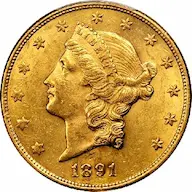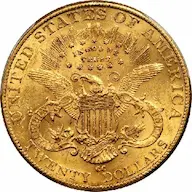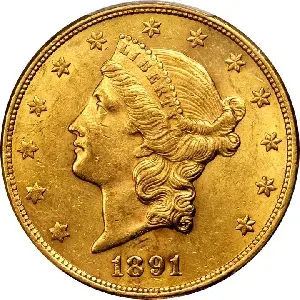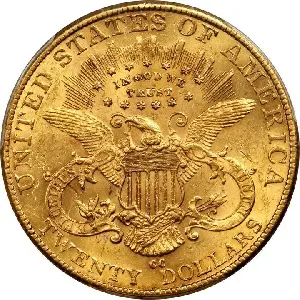1891-CC Coronet $20 Double Eagle
The political debates of the latter decades of the 19th century were centered around markedly different issues compared to those we hear about in current times. Back then, political factions divided sharply over the free coinage of silver versus the gold standard.(1)
One thing that has remained consistent (perhaps since the beginning of time) is the role of politics in allocating government funding.
Although President Benjamin Harrison in 1885 ordered the resumption of coining operations at the Carson City Mint, there were anti-silver influences in his administration that froze out Nevada during the 1891 budgeting process.
On July 18, 1891, the Nevada State Journal bellowed angrily "Nevada, it will be observed, does not get a dollar.” Continuing, the irritated Journal editors complained "The appropriation made for the expenses of the Carson Mint were so small that the employees have to work for reduced wages, or quit."
There were no $20 gold pieces struck at Carson City during the first six months of 1891, concentrating rather on Morgan dollars, $5 half eagles, and $10 eagles. Understandably, the situation in the second half of the year was not much better -- the mint delivered just 5,000 double eagles, the lowest mintage of that denomination since 1870, the first year of operation at the frontier mint facility.
Numismatists speculate about 1,000 to 2,000 of the 1891-CC double eagles were retained in the western U.S. economy, but the rest were exported to Europe, where they were worth more than face value. It is reported the Bank of England melted down many American double eagles and had the Royal Mint convert them to British coinage.
A few hundred of the 1891-CC double eagle escaped the foreign melting pots and eventually found their way back home, where grateful collectors welcomed them with open arms.(2)
If it were not for a relatively high survival rate of 6.2%,(3) the 1891-CC $20 would be on par with the hallowed 1870-CC (1.1% survivorship(4)). Still, the 1891-CC is rare in all grades, explaining the surging prices it has enjoyed for many decades.
| Estimated survivors in all grades: 308 ?
The survivor estimate from PCGS represents an average of one or more experts' opinions as to how many examples survive of a particular coin in all grades. Survival estimates include coins that are raw, certified by PCGS, and certified by other grading services. Learn more at PCGS. |
| PCGS Rarity Scale: 6.3 ?
The 'PCGS CoinFacts Rarity Scale' assesses the relative rarity of all U.S. coins, based on estimated surviving examples. The scale runs from 1.0 to 10.0. The higher the number, the rarer the coin.
Learn more at PCGS. |
| Search for the 1891-CC Coronet $20 Double Eagle on eBay** |
Preview of eBay selection:
 |
 |
| Trendline Avg = 20.04 | BETTER |
 |
 |
| Trendline Avg = 20.04 | BETTER |
Historic Value Trend Charts:
| Last updated 10-14-25 | Return to Key Date Coin List | |
| Compare to Common Date Coin of Same Type | ||
|
|
||
| Download Charts to Your Computer | ||
Sources
1. Stack's Bowers Galleries. 1891-CC Liberty Double Eagle. Aug 2012 Auction.
2. Stack's Bowers Galleries. 1891-CC Liberty Head Double Eagle. Aug 2022 Auction.
3. PCGS. 1891-CC $20 (Regular Strike).
4. PCGS. 1870-CC $20 (Regular Strike).
**Many very fine coin dealers sell on eBay. At any point in time, there may be over one million search results for United States coins. This includes quite a few of the recommendations on our Key Date Coin List.
If you’re thinking about purchasing a rare coin, eBay is certainly worth a look. For your convenience, the links from this site to eBay are coded to bring up only coins certified by PCGS and NGC.
As is always, always the case, never buy a valuable coin from a seller whose trustworthiness cannot be verified. Learn more about this at our chapter Best Places to Buy Coins, which also has a section on doing business on eBay.
In the interest of full disclosure, Rare Coins 101 receives a small commission anytime someone connects to eBay from this site and purchases something.
Coin images by Stack's Bowers Galleries.


